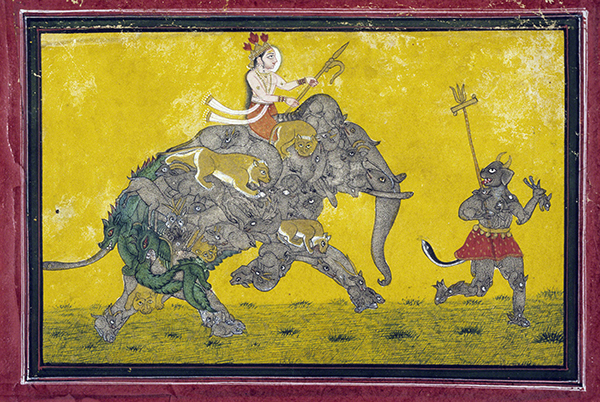World Watercolor Month: Kota School
I imagine July is World Watercolor Month because many artists take advantage of the beautiful summer weather to paint out of doors. I never fail to admire artists who achieve amazing works in this medium, particularly because my own efforts at watercolor, even as studies for later paintings, are rather sad. But we can appreciate the work of competent watercolorists from museum collections! Especially this example from India. I’ve always been fascinated with the “composite animals” in Islamic and Hindu painting.
 |
| Kota School, India, Composite Elephant Carrying a Divine Rider Preceded by a Composite Demon, from Kota, Rajasthan, ca. 1760. Opaque watercolor and gold leaf on paper, 7 15/16" x 11 5/8" (20.2 x 29.5 cm). © 2021 Philadelphia Museum of Art. (PMA-1683) |
In an elaborate metaphor taken from Persian painting, but also popular in India, both the elephant and the demon who walks in front are composed of masses of smaller, intertwined animals, many devouring, butting, or biting their neighbors. The animals include a black buck antelope, Indian hares, lions, fish, goats, dragons, a cobra, and a ring-tailed rodent that may be a civet. Atop the elephant is a lotus-crowned deity carrying a large elephant goad. Although no name appears, the figure is most likely Indra, Lord of the Heavens. Indra's vahana (vehicle) is the great elephant Airavata, progenitor of all elephants. Large as a storm cloud, Airavata supports the eastern quarter of the universe.
It's hard to escape the supernatural aspect of this work, as the elephant is given more mystic allusions as an intertwined (symplegma) animal form. The Greek word symplegma means a complex “tangle” of variant life forms, as opposed to the compound creature that has different extremities from different species, forming an odd composite creature. A good example of the opposite of symplegma would be the ancient Greek mythical creature Chimera, a mix of a lion’s head on a goat’s body with a snake for a tale.
Painting in India flourished as early as 200 BCE in the form of frescoes in Buddhist cave complexes such as Ajanta. There is little extant Hindu wall painting from the same period except for fragments at Ellora and Thanjavur. The Mughal period (1526–1756) ushered in Persian and European influence in painting, as well as an interest in scenes of everyday life of both nobles and common people and portraiture in particular.
In the 1400s, the introduction of papermaking from China and the development of a vernacular literature encouraged the flourishing of painting in the form of book illustration. Books of popular stories written in a language everyone could understand—rather than Sanskrit that only the upper class could read—resulted in a desire for illustration. This led to the development of numerous local schools of painting.
Despite the influence of Mughal court painting, many regional schools in Rajasthan (Rajput painting) maintained distinctively indigenous styles. In the Punjab, dominated by local princes, the various courts developed styles that were the synthesis of Mughal and Rajput painting, a blending of the real and the conceptual.
One of the preferred topics in these paintings was the favorite royal sport: tiger hunting. They portrayed the king mounted on elephant during the hunt. These paintings captured the movements of the animals, most prominent among them being the elephant. Stress was given on the energy and magnificence of the elephant rather than its adornment. Artists belonging to the Kota school of Rajasthan were considered the best in depicting the elephant.
Correlations to Davis programs: Explorations in Art 2E Grade 2: 3.4; Explorations in Art 2E Grade 3: 5.2; Explorations in Art 2E Grade 6: 3.7: A Personal Journey 2E: 5.3; A Global Pursuit 2E: 3.5; Experience Painting: Chapter 4; Discovering Art History 4E: 4.2


Comments